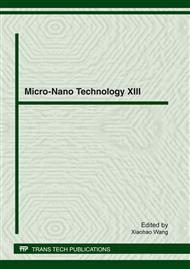p.406
p.411
p.415
p.423
p.427
p.435
p.440
p.447
p.451
Study on Anodic Bonding Process of Slender Vitreous Body
Abstract:
With the development of MEMS technology, the pressure sensors, one of mature MEMS devices, are expected to better performance. In order to improve sensors performance, supporting vitreous body shape is elongated and thinned. But the variety of the vitreous body shape brings the new difficulties for anodic bonding between the vitreous body and the silicon during the sensors production, and causes that the common bonding process conditions are unavailable and bonding failure rate dramatically increases. Therefore, this article analyzes the bonding process between slender vitreous body and silicon, and researches on the influence of the vitreous body variety on the pressure, temperature and voltage. The results showed that the bonding is the best when the cantilever elastic deformation is less than 0.5mm, interface temperature loaded from the silicon is 415°C and the voltage 1200V is loaded from the position near H=2mm.
Info:
Periodical:
Pages:
435-439
Citation:
Online since:
February 2012
Authors:
Keywords:
Price:
Сopyright:
© 2012 Trans Tech Publications Ltd. All Rights Reserved
Share:
Citation:


